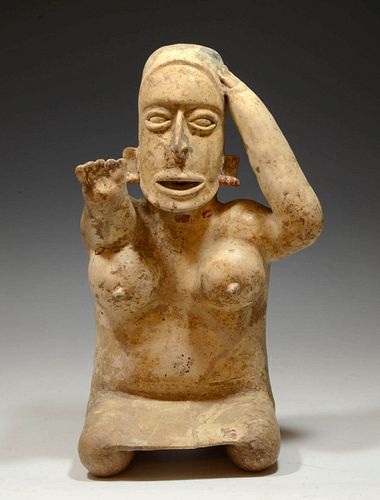Jalisco Ameca Pottery Kneeling Female Figure
Lot 218a
About Seller
Artemis Gallery
686 S Taylor Ave, Ste 106
Louisville, CO 80027
United States
Selling antiquities, ancient and ethnographic art online since 1993, Artemis Gallery specializes in Classical Antiquities (Egyptian, Greek, Roman, Near Eastern), Asian, Pre-Columbian, African / Tribal / Oceanographic art. Our extensive inventory includes pottery, stone, metal, wood, glass and textil...Read more
Categories
Estimate:
$2,800 - $3,200
Absentee vs Live bid
Two ways to bid:
- Leave a max absentee bid and the platform will bid on your behalf up to your maximum bid during the live auction.
- Bid live during the auction and your bids will be submitted real-time to the auctioneer.
Bid Increments
| Price | Bid Increment |
|---|---|
| $0 | $25 |
| $300 | $50 |
| $1,000 | $100 |
| $2,000 | $250 |
| $5,000 | $500 |
| $10,000 | $1,000 |
| $20,000 | $2,500 |
| $50,000 | $5,000 |
| $100,000 | $10,000 |
| $200,000 | $20,000 |
About Auction
By Artemis Gallery
Oct 7, 2021
Set Reminder
2021-10-07 10:00:00
2021-10-07 10:00:00
America/New_York
Bidsquare
Bidsquare : Exceptional Antiquities Ethnographic Fine Art
https://www.bidsquare.com/auctions/artemis-gallery/exceptional-antiquities-ethnographic-fine-art-7537
Museum-worthy examples of Egyptian, Greek, Roman, Etruscan, Near Eastern, Far East / Asian, Pre-Columbian, African / Tribal, Oceanic, Native American, Spanish Colonial, Fossils, Ancient Jewelry, Fine / Visual Arts, so much more! Artemis Gallery info@artemisgallery.com
Museum-worthy examples of Egyptian, Greek, Roman, Etruscan, Near Eastern, Far East / Asian, Pre-Columbian, African / Tribal, Oceanic, Native American, Spanish Colonial, Fossils, Ancient Jewelry, Fine / Visual Arts, so much more! Artemis Gallery info@artemisgallery.com
- Lot Description
Pre-Columbian, West Mexico, Jalisco, Ameca-Etzatlan style, Protoclassic Period, ca. 100 BCE to 250 CE. An exceptional hollow-bodied pottery female figure depicted kneeling with a skirt covering her thighs, all enveloped in a creamy beige slip. She poses seductively with her left arm reaching behind her head and her right hand stretched outwards, while her globular breasts emphasize her powerful feminine physique. Supported by square shoulders, her elongated head exhibits a calm countenance of deep-set, almond-shaped eyes, a sharp nose, and full lips held open as though mid-chant, all flanked by a pair of large ears. A helmet-like coiffure caps her head. Size: 15" H (38.1 cm)
West Mexican shaft tomb figures like this example derive their names from the central architectural feature that we know of from this culture. Jalisco, located on Mexico's southwestern coast, was part of the shaft tomb culture during this time, along with neighbors in nearby Colima and Nayarit. These people would build generally rectangular vertical or near-vertical shafts down from the ground level - usually about 3 to 20 meters deep - through tepetate, the volcanic tuff that makes up the geology of the region, to narrow horizontal tunnels that led to one or more vaulted or rounded burial chambers.
These shafts were almost always dug beneath a dwelling, probably a family home, and seem to have been used as family mausoleums, housing the remains of many related individuals. Figures like this one were placed into the tombs; researchers believe that they were placed around the edges facing inward, as if in conversation with the dead. Grouped with other figures, and alongside clay bowls, and boxes, figures like this one were positioned around the body (or bodies), near the skull.
Unfortunately, we lack the necessary information to fully understand what these figures were made for - did they represent everyday people, even individuals? Were they religious? Were they created to mediate between the living and the dead? Whatever their purpose, today they are beautiful artwork and reminders of the mysterious past.
Provenance: private New York, New York, USA collection; ex-J. Ohara collection, Texas, USA, acquired in the 1960s to 1970s
All items legal to buy/sell under U.S. Statute covering cultural patrimony Code 2600, CHAPTER 14, and are guaranteed to be as described or your money back.
A Certificate of Authenticity will accompany all winning bids.
PLEASE NOTE: Due to recent increases of shipments being seized by Australian & German customs (even for items with pre-UNESCO provenance), we will no longer ship most antiquities and ancient Chinese art to Australia & Germany. For categories of items that are acceptable to ship to Australia or Germany, please contact us directly or work with your local customs brokerage firm.
Display stands not described as included/custom in the item description are for photography purposes only and will not be included with the item upon shipping.
#167971Repaired at base and skirt. Root marks on surface. Otherwise, excellent with great remains cream slip pigment and scattered mineral deposits.Condition
- Shipping Info
-
All shipping is handled in-house for your convenience. Your invoice from Artemis Gallery will include shipping calculation instructions. If in doubt, please inquire BEFORE bidding for estimated shipping costs for individual items.
-
- Buyer's Premium



 EUR
EUR CAD
CAD AUD
AUD GBP
GBP MXN
MXN HKD
HKD CNY
CNY MYR
MYR SEK
SEK SGD
SGD CHF
CHF THB
THB
















